Map Case No. 2
Stores Ref. V2/VB 0251 Case, map, G.S. No. 2, Mk. 1
Stores Ref. V3/VC 0251 Case, map, G.S. No. 2, Mk. 1
Stores Ref. W10/VC 0251 Case, map, G.S. No. 2, Mk. 1
Stores Ref. 23 / 248 Case, map, No. 2, Mk. 1
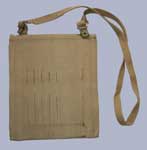
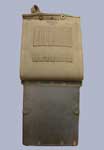
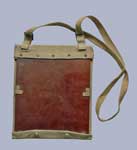 This Case was approved by LoC § B4097, approved 17 August 1940. The fact of this wartime date may account for its “ersatz” appearance. It was a “skeleton” design, open-sided and consisted of a web flap rivetted to a board made of Tufnol, a pressed composite board, made of resin impregnated cloth. Hinged to the top edge, a thick secondary “flap” of celluloid covered the Tufnol. Half-way down each long edge, a swivelling clip closed off the “sandwich” of celluloid / folded map / Tufnol back-piece, with two further clips on the lower edge. The flap was longer than the board, which allowed it to be secured to a pair of press studs on the back of the Tufnol board, mounted through it.
This Case was approved by LoC § B4097, approved 17 August 1940. The fact of this wartime date may account for its “ersatz” appearance. It was a “skeleton” design, open-sided and consisted of a web flap rivetted to a board made of Tufnol, a pressed composite board, made of resin impregnated cloth. Hinged to the top edge, a thick secondary “flap” of celluloid covered the Tufnol. Half-way down each long edge, a swivelling clip closed off the “sandwich” of celluloid / folded map / Tufnol back-piece, with two further clips on the lower edge. The flap was longer than the board, which allowed it to be secured to a pair of press studs on the back of the Tufnol board, mounted through it.
The underside of the web flap was pocketed and looped for chinagraph pencils, with one wider pocket and loop for the rectangular Service Protractor. On the back of the Case, two ¾-inch buckles on web chapes were provided for a shoulder sling. The example shown here is maker marked "W & G" (Waring & Gillow) and dated 1944. From the Carl Woods Collection, photographs © Carl Woods 2011.
The Case, map, No. 2, Mk. 1, minus “G.S.” is listed in Section 23 of the 1958 edition of Air Publication 1086, Priced Vocabulary of Royal Air Force Equipment, which was specified for the R.A.F. Regiment only. The nomenclature ought to mirror that of the Army, which would mean the “ersatz” Mark 1 was still in service with the R.A.F. and not the “de luxe” Mark 1/1. Note that it was not blue-grey webbing.
Stores Ref. V3/VC 0251 Case, map. G.S. No. 2 Mk I Emergency Pattern
Stores Ref. W10/VC 8136 Case, map. G.S. No. 2 Mk 1/1
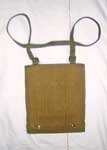


 This variant is presumed to have been added to V.A.O.S. Section V3, bypassing V2. Unfortunately until 1944/45, codes were not marked on webbing, though some earlier examples were retro-marked. The Sealed Pattern of this variant has a hand-written O.H.M.S. label of Cases, map, E.P. Hand-written on the reverse is Approved 2/5/44. Attached to this label is a second, type-written label CASES MAP G.S. No. 2 EMERGENCY PATTERN APPROVED the latter word then deleted. A separately attached label states CAT. NO. VC 0251 WORKING PATTERN CASES. MAP. G.S. No. 2 MK. I, with dates ranging from 1957 to 1963 on its reverse. The front of the label has a hand-written NOT FOR ISSUE, though this is more probably a final annotation. The makers of this 1944 dated example, P.S.S., were Princess Silk Shades, one of many companies brought into the production of webbing during the Second World War.
This variant is presumed to have been added to V.A.O.S. Section V3, bypassing V2. Unfortunately until 1944/45, codes were not marked on webbing, though some earlier examples were retro-marked. The Sealed Pattern of this variant has a hand-written O.H.M.S. label of Cases, map, E.P. Hand-written on the reverse is Approved 2/5/44. Attached to this label is a second, type-written label CASES MAP G.S. No. 2 EMERGENCY PATTERN APPROVED the latter word then deleted. A separately attached label states CAT. NO. VC 0251 WORKING PATTERN CASES. MAP. G.S. No. 2 MK. I, with dates ranging from 1957 to 1963 on its reverse. The front of the label has a hand-written NOT FOR ISSUE, though this is more probably a final annotation. The makers of this 1944 dated example, P.S.S., were Princess Silk Shades, one of many companies brought into the production of webbing during the Second World War.





 This Case is a pocket, open at the top, a single piece of webbing comprising flap and back, with a turn-back to which a pair of male (spigot) halves of press fasteners are fixed. To this is stitched a “picture frame” of webbing, with a piece of celluloid stitched into the frame. The sides and bottom are gusseted to accommodate several folded maps. The flap is fitted out for pencils and a protractor, exactly like the first issue. From the Karkee Web Collection.
This Case is a pocket, open at the top, a single piece of webbing comprising flap and back, with a turn-back to which a pair of male (spigot) halves of press fasteners are fixed. To this is stitched a “picture frame” of webbing, with a piece of celluloid stitched into the frame. The sides and bottom are gusseted to accommodate several folded maps. The flap is fitted out for pencils and a protractor, exactly like the first issue. From the Karkee Web Collection.
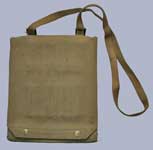
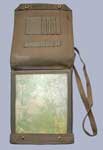
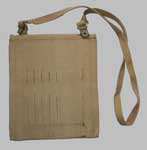 The second example shown here is maker marked "Bagcraft Ltd." and dated 1944. From the Carl Woods Collection, photographs © Carl Woods 2011.
The second example shown here is maker marked "Bagcraft Ltd." and dated 1944. From the Carl Woods Collection, photographs © Carl Woods 2011.